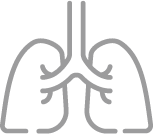Understanding the common causes of bronchiectasis and identifying its individual symptoms will empower you to find the best treatment plan for reducing respiratory infections, improving air flow, and preventing further damage to your airways.
To help you get familiar with this chronic lung condition and how it can affect your everyday life, here’s the answers to some questions you may have about bronchiectasis.
 What Causes Bronchiectasis?
What Causes Bronchiectasis?
Bronchiectasis is caused by recurring respiratory inflammation and infections that irreversibly damage your airways (i.e. bronchi). With each new cycle of inflammation, your airways become abnormally widened, making it difficult to move air in and out of the body. This prevents your lungs from mobilizing and clearing mucus, and as mucus continues to build up, your body becomes more prone to respiratory infections, starting the cycle all over again.
So, what causes an individual to have bronchiectasis?
According to the American Thoracic Society, there are multiple causes of bronchiectasis, including:
- Genetic Disorders
- Immune System Deficiencies
- Repeated Lung Infections
- Pulmonary Aspiration1

Genetic Disorders
Individuals living with certain hereditary conditions like cystic fibrosis or a neuromuscular condition that makes it difficult to clear mucus naturally, may develop bronchiectasis later in life. These conditions, in particular, cause an individual to experience mucus build-up and repeated infection. Though they do not directly cause bronchiectasis, their recurring symptoms can worsen and develop into bronchiectasis over time: “Bronchiectasis often occurs secondary to another medical condition.”2

Immune System Deficiencies
The immune system, which works to protect our bodies from the spread of germs and bacteria, plays an important role in fighting off the onset of an infection. If you or a loved one is living with an immune deficiency disease, the condition may interfere with your ability to fight a respiratory infection, creating a worsening of symptoms that can damage your airways. 3

Recurring Lung Infections
As mentioned above, when a person experiences recurring lung infections, they become more susceptible to permanent airway damage, making it more difficult to mobilize the lungs and clear mucus naturally.

Difficulty Swallowing Liquids
According to the National Heart, Lung, and Blood Institute, chronic pulmonary aspiration can cause individuals to inhale foods and other fluids into their lungs and inflame the airways. The recurring inflammation can severely damage the airways, create difficulty swallowing, and cause people to experience symptoms of bronchiectasis.
Another possible cause of bronchiectasis may include damage to an individual’s cilia, which are the tiny hair-like structures located on a person’s airways responsible for sweeping mucus out of the lungs: “In people with bronchiectasis, cilia are destroyed. Mucus and particles can’t be cleared from the lungs.”
Are certain people more susceptible to this chronic lung condition?
Though bronchiectasis can affect an individual at any age, women in their 60s tend to be more susceptible to its symptoms. According to Medical News Today, “Since 2001, the number of diagnoses has increased by around 8 percent each year.”6
What Bacteria Causes Bronchiectasis?
According to National Jewish Health®, certain bacterial infections, such as Pseudomonas aeruginosa, Staphylococcus aureus, tuberculosis, and Klebsiella, can further damage the airways, causing patients to experience bronchiectasis-related symptoms.7
In a recent article, we discussed the effects of mucus buildup in the lungs. When your body is unable to naturally clear mucus on its own, you become more prone to respiratory infections. Besides making you feel fatigued and experiencing difficulty breathing, these types of infections can also worsen your chronic lung condition and cause your symptoms to worsen, which often requires hospitalization.
What Are the Symptoms of Bronchiectasis?
Understanding the causes of bronchiectasis is essential but learning its symptoms will allow you to identify your condition and start asking your clinician about how to get an accurate bronchiectasis diagnosis.
Common Symptoms of Bronchiectasis:
- Chronic cough that produces mucus
- Recurrent respiratory infections
- Breathlessness and wheezing
- General fatigue
It’s important to recognize that many of the symptoms of bronchiectasis share similarities with COPD (chronic obstructive pulmonary disorder). For loved ones living with COPD, they may begin to experience a worsening of symptoms (also known as exacerbations), which could be an early sign of bronchiectasis.
Can a person have an overlap of bronchiectasis and COPD symptoms? The answer is yes. And if not treated properly, this comorbid condition will result in further damage to the lungs and airways. According to Dr. Frederic Seifer, a renowned pulmonary specialist, there are several bronchiectasis signs and symptoms that all COPD patients should look out for, including:
- Multiple courses of antibiotics over a period of years
- Repeated lower respiratory infections
- Yellow or green sputum
If you or a loved one are living with COPD and are experiencing any of these worsening symptoms, you’ll want to talk to your doctor about getting a High Resolution Chest Computerized Tomography (HRCT) scan to properly diagnosis bronchiectasis.
For more information on bronchiectasis and COPD, request an informational packet today.
Can Bronchiectasis Go Away?
Though treating your bronchiectasis symptoms can help you reduce the cycle of recurring inflammation and infection that requires antibiotics and hospitalization, bronchiectasis is a permanent condition. However, living with bronchiectasis doesn’t mean you can’t achieve a long, fulfilling life.
Using effective airway clearance via high frequency chest wall oscillation (HFCWO) therapy has helped bronchiectasis patients experience relief from their chronic symptoms. SmartVest—a HFCWO therapy device clinically proven to help minimize infection and antibiotic use, as well as reduce recurring infections that require hospitalization—has proven studies demonstrating its ability to help stabilize lung function and prevent further damage to the airways.8
“I have noticed an increase in my energy level, so my productivity is getting back to normal and I have discovered that I am now able to breathe more deeply without coughing. When I started SmartVest, [my goal was to] sit through worship and once again sing all of the hymns and read responsively without having to stop for coughing. This past Sunday I coughed only once – very lightly – and not during singing or reading. And my friends don’t move when I sit down!” -Connie

Many patients have experienced the benefits of using SmartVest for their airway clearance therapy. This effective approach to treating bronchiectasis symptoms has allowed them to get back to the activities they love and breathe easier. To read what others are saying, read our SmartVest success stories for support and inspiration!
Choose SmartVest for Your Bronchiectasis Symptoms
To learn more about the benefits of using SmartVest, request an informational packet today or explore our website to learn how to talk to your doctor about making SmartVest a part of your airway clearance therapy!

